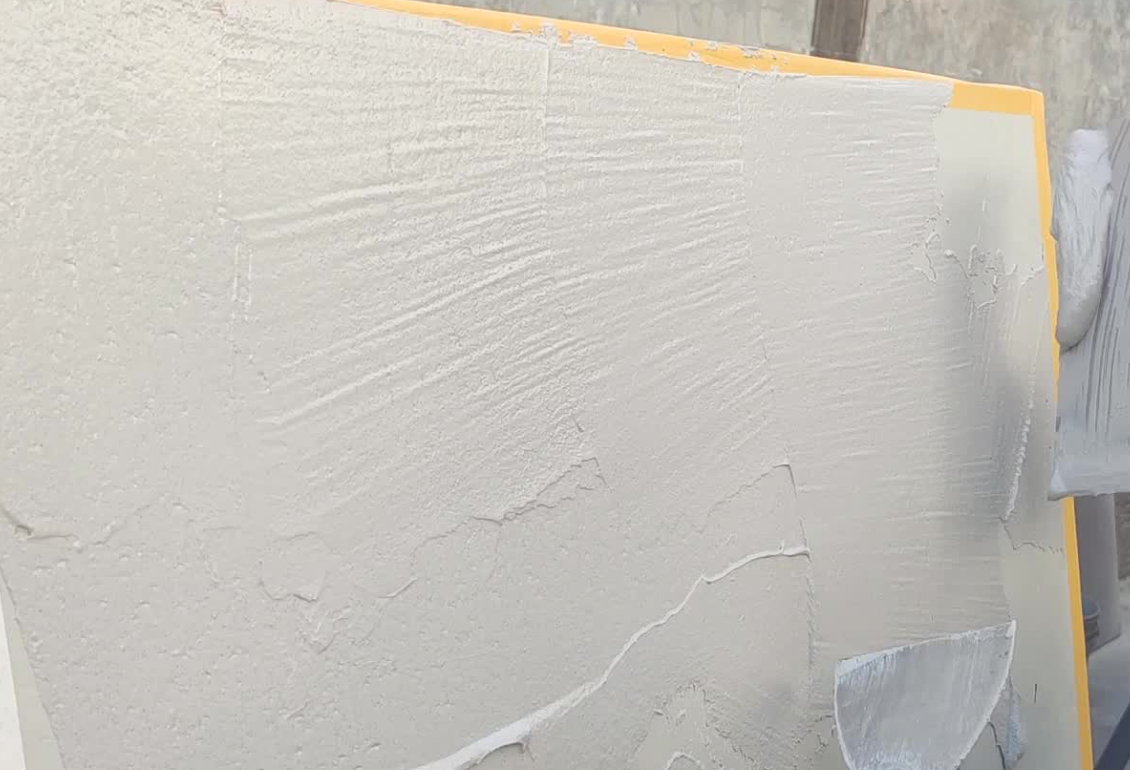Requirements and Impacts on the Putty Layer for Exterior Stone-Effect Coatings
Exterior stone-effect coatings and ordinary exterior paints have different requirements and impacts on the putty layer. Stone-effect coatings require high flexibility and adhesion due to their thickness and weight, while ordinary paints demand high smoothness and sandability for a thin, even finish. Insufficient strength or flexibility in the putty layer can cause cracking or delamination for stone-effect coatings, whereas ordinary paints may show inconsistent gloss if the putty layer is not properly sanded.

Requirements and Impacts on the Putty Layer for Exterior Stone-Effect Coatings and Ordinary Exterior Paints
Requirements for the Putty Layer
1. Color Requirements
- Exterior Stone-Effect Coatings
- Requirement: Dark-colored putty can be used.
- Reason: Stone-effect coatings have strong covering power and a rich variety of colors. The color of the putty layer has little impact on the final appearance.
- Ordinary Exterior Paints
- Requirement: Generally, light-colored putty, such as white or slightly yellow, is preferred. If the putty is dark, it will place higher demands on the covering power of the paint.
- Reason: Light-colored paints have more difficulty covering the underlying color. Light-colored putty can reduce the amount of paint needed, lower costs, and ensure a uniform wall color.
2. Smoothness Requirements
- Exterior Stone-Effect Coatings
- Requirement: The smoothness of the putty layer is relatively low. Stone-effect coatings have a certain leveling function and can cover minor unevenness through the spraying process.
- Reason: The granular texture and spraying process of stone-effect coatings can mask slight unevenness in the putty layer.
- Ordinary Exterior Paints
- Requirement: High smoothness is required. The smoothness of the putty layer directly affects the smoothness and gloss of the paint after application.
- Reason: Ordinary exterior paints have a thin coating and require a high degree of smoothness. A smooth putty layer ensures even application and a better decorative effect.
3. Sandability Requirements
- Exterior Stone-Effect Coatings
- Requirement: Generally, no sanding is needed. The application process of stone-effect coatings usually does not require sanding of the putty layer.
- Reason: The spraying process of stone-effect coatings can cover the rough surface of the putty layer, eliminating the need for sanding to achieve a smooth effect.
- Ordinary Exterior Paints
- Requirement: The putty layer needs good sandability. If some areas of the wall are difficult to sand, it will lead to inconsistent gloss and matte effects after the paint is applied, affecting the overall appearance.
- Reason: Ordinary exterior paints require sanding of the putty layer before application to ensure the smoothness and evenness of the wall, thereby achieving a better decorative effect.
4. Hardness Requirements
- Exterior Stone-Effect Coatings
- Requirement: High hardness is required. Otherwise, delamination may occur.
- Reason: Stone-effect coatings have a thick layer and a large weight, requiring the putty layer to provide sufficient support and adhesion to prevent the coating from falling off.
- Ordinary Exterior Paints
- Requirement: The hardness requirement is not very high. If the hardness of a small area of the putty layer is not enough, it can be improved through the anchoring adhesion of the paint penetrating into the putty layer.
- Reason: Ordinary exterior paints have a thin coating and a light weight, placing lower demands on the support provided by the putty layer. Even if the putty layer has slightly insufficient hardness, the paint can still provide some adhesion through penetration and bonding.
5. Flexibility Requirements
- Exterior Stone-Effect Coatings
- Requirement: High flexibility is required. Stone-effect coatings themselves have good flexibility. If the flexibility of the putty layer does not match, it is easy to crack due to uneven shrinkage.
- Reason: Stone-effect coatings have a thick layer and good flexibility. If the putty layer lacks flexibility, it is prone to cracking when there are changes in temperature or deformation of the base layer.
- Ordinary Exterior Paints
- Requirement: A certain degree of flexibility is needed to resist destructive stresses such as ultraviolet rays, temperature differences, and freeze-thaw cycles.
- Reason: Although ordinary exterior paints have a thin coating, they still need some flexibility to withstand long-term environmental damage and prevent cracking or peeling of the coating.
6. Adhesion Requirements
- Exterior Stone-Effect Coatings
- Requirement: Very high. Insufficient adhesion can lead to the stone-effect coating and putty layer detaching from the substrate.
- Reason: Stone-effect coatings have a thick layer and a large weight, requiring the putty layer to provide strong adhesion to prevent the coating from falling off.
- Ordinary Exterior Paints
- Requirement: Generally, the load is light, so the requirement is moderate. Ordinary exterior paints have a thin coating and a light weight, placing lower demands on the adhesion of the putty layer.
- Reason: Ordinary exterior paints have a thin coating and a light weight, so the requirement for the adhesion of the putty layer is relatively low. Even if the adhesion is slightly insufficient, it is not easy to cause detachment.
Impacts on the Putty Layer
1. Strength Aspect
- Exterior Stone-Effect Coatings
- Impact: If the putty layer has insufficient strength, water ingress can lead to putty powdering, causing hollowing and detachment of the putty.
- Reason: Stone-effect coatings have a thick layer and a large weight, placing high demands on the support provided by the putty layer. If the putty layer lacks strength, it is prone to powdering when water enters, leading to coating detachment.
- Ordinary Exterior Paints
- Impact: If the hardness of a small area of the putty layer is not enough, it can be improved through the anchoring adhesion of the paint penetrating into the putty layer.
- Reason: Ordinary exterior paints have a thin coating and a light weight, placing lower demands on the support provided by the putty layer. Even if the putty layer has slightly insufficient hardness, the paint can still provide some adhesion through penetration and bonding.
2. Cracking Aspect
- Exterior Stone-Effect Coatings
- Impact: Insufficient flexibility of the putty layer, which does not match the flexibility of the stone-effect coating, can easily lead to cracking due to uneven shrinkage.
- Reason: Stone-effect coatings have a thick layer and good flexibility. If the putty layer lacks flexibility, it is prone to cracking when there are changes in temperature or deformation of the base layer.
- Ordinary Exterior Paints
- Impact: The putty layer needs a certain degree of flexibility; otherwise, it is more susceptible to destructive stresses such as ultraviolet rays, temperature differences, and freeze-thaw cycles, which can lead to cracking.
- Reason: Although ordinary exterior paints have a thin coating, they still need some flexibility to withstand long-term environmental damage and prevent cracking or peeling of the coating.
3. Delamination Aspect
- Exterior Stone-Effect Coatings
- Impact: Insufficient adhesion of the putty layer can lead to the stone-effect coating and putty layer detaching from the substrate.
- Reason: Stone-effect coatings have a thick layer and a large weight, requiring the putty layer to provide strong adhesion to prevent the coating from falling off.
- Ordinary Exterior Paints
- Impact: Generally, the load is light, so the impact of insufficient adhesion on delamination is relatively small.
- Reason: Ordinary exterior paints have a thin coating and a light weight, placing lower demands on the adhesion of the putty layer. Even if the adhesion is slightly insufficient, it is not easy to cause detachment.
4. Smoothness Aspect
- Exterior Stone-Effect Coatings
- Impact: The coating itself has a certain leveling function, so the smoothness of the putty layer has little impact on the final effect.
- Reason: The granular texture and spraying process of stone-effect coatings can mask slight unevenness in the putty layer.
- Ordinary Exterior Paints
- Impact: If the putty layer is uneven, it will lead to poor smoothness after the paint is applied, affecting the overall decorative effect.
- Reason: Ordinary exterior paints have a thin coating and require a high degree of smoothness. A smooth putty layer ensures even application and a better decorative effect.
5. Effect Aspect
- Exterior Stone-Effect Coatings
- Impact: Generally, no sanding is needed, and the sandability of the putty layer has little impact on the final effect.
- Reason: The spraying process of stone-effect coatings can cover the rough surface of the putty layer, eliminating the need for sanding to achieve a smooth effect.
- Ordinary Exterior Paints
- Impact: If some areas of the putty layer are difficult to sand, it will lead to inconsistent gloss and matte effects after the paint is applied.
- Reason: Ordinary exterior paints require sanding of the putty layer before application to ensure the smoothness and evenness of the wall, thereby achieving a better decorative effect.
Comparison Table
| Requirement/Impact Item | Exterior Stone-Effect Coatings | Ordinary Exterior Paints |
|---|---|---|
| Color Requirement | Dark-colored putty can be used | Generally, light-colored putty such as white or slightly yellow is preferred. If the putty is dark, it will place higher demands on the covering power of the paint. |
| Smoothness Requirement | Relatively low. The coating itself has a certain leveling function | High. The smoothness of the putty layer directly affects the smoothness and gloss of the paint after application |
| Sandability Requirement | Generally, no sanding is needed | Good sandability is required. Otherwise, it will affect the gloss and decorative effect of the paint after application |
| Hardness Requirement | High. Otherwise, delamination may occur | Not very high. If the hardness of a small area of the putty layer is not enough, it can be improved through the anchoring adhesion of the paint penetrating into the putty layer |
| Flexibility Requirement | High. The coating itself has good flexibility. If the flexibility of the putty layer does not match, it is easy to crack due to uneven shrinkage | A certain degree of flexibility is needed to resist destructive stresses such as ultraviolet rays, temperature differences, and freeze-thaw cycles |
| Adhesion Requirement | Very high. Insufficient adhesion can lead to the coating and putty layer detaching from the substrate | Moderate. Generally, the load is light, so the requirement is not very high |
| Strength Impact | If the putty layer has insufficient strength, water ingress can lead to putty powdering, causing hollowing and detachment of the putty | If the hardness of a small area of the putty layer is not enough, it can be improved through the anchoring adhesion of the paint penetrating into the putty layer |
| Cracking Impact | Insufficient flexibility of the putty layer, which does not match the flexibility of the coating, can easily lead to cracking due to uneven shrinkage | The putty layer needs a certain degree of flexibility; otherwise, it is more susceptible to destructive stresses such as ultraviolet rays, temperature differences, and freeze-thaw cycles, which can lead to cracking |
| Delamination Impact | Insufficient adhesion of the putty layer can lead to the coating and putty layer detaching from the substrate | Generally, the load is light, so the impact of insufficient adhesion on delamination is relatively small |
| Smoothness Impact | The coating itself has a certain leveling function, so the smoothness of the putty layer has little impact on the final effect | If the putty layer is uneven, it will lead to poor smoothness after the paint is applied, affecting the overall decorative effect |
| Effect Impact | Generally, no sanding is needed, and the sandability of the putty layer has little impact on the final effect | If some areas of the putty layer are difficult to sand, it will lead to inconsistent gloss and matte effects after the paint is applied |
